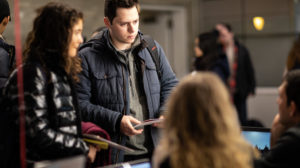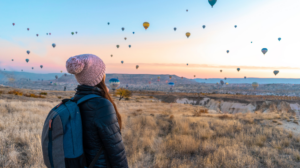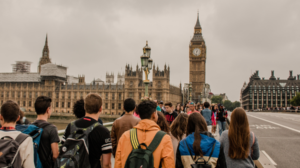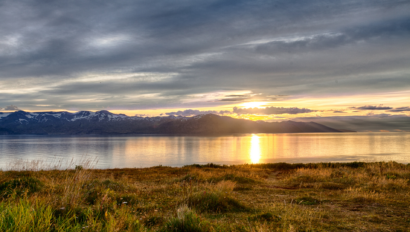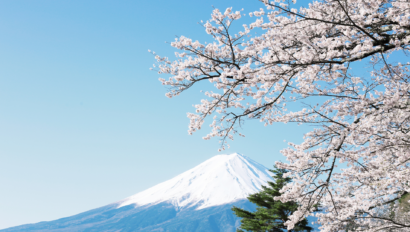The Basics: What to Expect When You Arrive
By Julia Preszler
When I departed the U.S. for San José, I didn’t quite know what to expect. I didn’t know what my home and school would look like, what classes I would be taking, or how often I would be able to take trips to other parts of the country on the weekends. Two months in, daily life has fully taken shape. Here are some of the things I wish I had known before I left home.
Living Arrangements
All international students at Universidad Véritas live in homestays with local Costa Rican families. All of the homes are located in the Zapote district of the city and are a 5 to 15 minute walk to the school. There is also a shuttle to different parts of the neighborhood that leaves on the hour. Students may be the only guest in their home, or be paired with another student. Everyone gets their own room, though. The host family may consist of a single woman, a couple, or a family with kids. I live in an apartment with another American student and our host mom, Mary.
When I received my housing assignment before I arrived, I was surprised to see that the address was simply listed as “200 meters north of the law school’s main entrance.” I later found out that places in Costa Rica don’t have addresses, so this type of description is common.
Included with your homestay is breakfast and dinner each day, except for Saturday night dinners. My roommate and I typically eat breakfast prepared by our host mom at the house in the morning and dinner at her “soda,” the name for a small, traditional Costa Rican restaurant. Since Mary is a professional chef, the food is always very delicious.
The staple food in Costa Rica is rice and beans, so we have these with almost every meal. “Gallo pinto,” a mixture of rice, beans, peppers, and herbs, is a national favorite and frequently eaten for breakfast. Alongside the gallo pinto, Mary will often serve us a fried egg, some slices of avocado and/or tomato, and a slice of Costa Rican cheese that she fries on both sides.
For dinner, we will often have rice and beans, salad, and another meal component. I am a vegetarian, so Mary has been serving me falafel patties, zucchini and cauliflower that are breaded and fried, and soy-based fake meat. She also uses eggs and spinach to cook a thin, pancake-like discs. Sometimes, she mixes it up by serving us a burrito, pasta, or veggie lasagna.
Before I arrived, I expected that I would get tired of rice and beans. Now, I find myself craving them, especially around dinnertime.
The School
Universidad Véritas is a small design and arts school located in a residential area of the city. With fewer than 2,000 students, the college is about the size of my high school. Coming from a big university like Northeastern, it is nice to experience the closer community feel that you get when attending a smaller school. The school has a nice covered patio area with tables and chairs where you can study. There are also some nearby parks, but sometimes I wish the school had a more traditional “quad” we could hang out in.
The international program I am in is focused on environmental and social sciences and international relations. Interestingly, the subjects we study are very different from the topics the Costa Ricans at the university focus on.
There are about 150 students in the international program. I know the names of almost all of them, and have spoken to many of them. Again, it is nice to see what it is like to go to a school that is smaller than Northeastern. I think it is easier to get to know people when you run into the same students over and over. Some students, including myself, arrived at the beginning of September for a 16-week program. Others arrived about a month in to stay here for 12 weeks.
During the first month, we all just took one class — an intensive Spanish class held from 8 a.m. to noon Monday through Friday. The classes are divided into different levels, including Basic 1 and 2, Intermediate 1 and 2, and Advanced 1 and 2. In the summer before students arrive, they take an online placement test and schedule a brief Skype oral interview in Spanish so the professors can decide which level is best for you. After two semesters of Spanish at Northeastern, I placed in Basic 2. The levels of classes here are not exactly equivalent to the levels of classes at Northeastern. For example, Basic 2 here is more advanced than Basic 2 at NU. Since I only had class in the morning during the first month, and the homework load was pretty light, the afternoons were free to explore San José and get to know the other students in the program.
At the beginning of October, the elective classes began. Some students take a second Spanish class in October, so all of the electives take place in the afternoon. Because of the way Northeastern evaluates Universidad Véritas credits, I am only able to take three elective classes. I chose Sustainable Development, Tropical Ecology, and Agroecology. The class offerings are one of the biggest reasons that I chose this program. As a journalism major and environmental studies minor who aspires to pursue a career in environmental journalism, these classes sounded like great ways to learn more about the natural world and sustainable practices. All of my classes are held two days per week — Mondays and Wednesdays or Tuesdays and Thursdays — for two hours each time. There are no elective classes on Fridays.
All of the environmentally-focused classes and some classes in other subjects, too have an overnight weekend field trip and a day trip that are included in the price of the class. My field trips will all take place in November. Unfortunately, some of them overlap, so I had to pick and choose among some of them.
The Program: API
Within the international program, students are divided into smaller groups they came to Costa Rica through. Northeastern students are in the API group. API is a study abroad company that runs programs in locations all over the world. There are 9 other students in my group this semester. Most are from the northeast U.S., but a couple are from the west coast.
The API resident director is your point person for any questions or issues you have about your life here. They stay in contact with the university and the host families to make sure your Costa Rican experience goes smoothly. For example, if you are sick, the resident director can bring you to the clinic or hospital.
Twice a month, we have lunch at the API office, which is a five-minute walk from the university (and, conveniently, only about a one-minute walk from my apartment!) We also do one cultural activity per month. In September, we went to an exhibit of art by the Columbian artist Fernando Botero in the National Gallery of the Children’s Museum in San José. In October, we went to the Pepper Disco Club to try our hand at salsa dancing. (Everyone there was so good!) In November, I think we are going on a coffee and chocolate tour.
API also brings us on two weekend excursions. Last weekend we went to the town of La Fortuna, which is located north and slightly west of San José. From our hotel balcony, we could see Volcán Arenal, a conically-shaped active volcano that last erupted in 2010. On Saturday morning, our driver drove us closer to the base of the volcano and we went on a hike around the base. In the afternoon, we spent time at the hotel pool and bought lunch at the swim-up bar. Later, we went to pools that are fed by water that is warmed by the heat of the volcano. For dinner, we went into town and got some sushi. On Sunday morning, we climbed down and back up 500 steps so we could swim at the base of the La Fortuna waterfall.
Next weekend, we will go with API Bocas del Toro, an island off the Atlantic coast of Panama. On the itinerary is dolphin watching, snorkeling, and visiting Red Frog Beach.
The Visa
U.S. Citizens do not need a visa to enter Costa Rica for 90 days. Since the 16-week program is longer than that, API plans an international trip (the aforementioned weekend to Panama) in order to reset the 90 days so we can stay in Costa Rica until the end of the program. Once you spend 72 hours outside of the country and re-enter, you are good to go!

